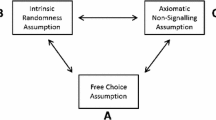Abstract
The notion of contextuality in quantum theory expresses that the result of a measurement (e.g. performed by Alice) depends on the experimental context or, more precisely, on other measurements (e.g. performed by Bob). This kind of contextuality presupposes that signals transferring information about Bob’s experiment to Alice (and vice versa) are excluded. In quantum physics this can be guaranteed if the two measurements are performed within the causal complements of their lightcones. In this case, signaling would violate special relativity. Some recent scenarios in cognitive science apply a similar non-signaling condition to test whether measurements on cognitive systems are contextual. For a refined discussion of contextuality in such scenarios, we argue that it is important to distinguish two types of signaling: (1) signaling that Alice and Bob can use to communicate, and (2) signaling that Alice and Bob cannot use to communicate. Lacking communication may be inconclusive for contextuality if signaling without communication is still present.
Access this chapter
Tax calculation will be finalised at checkout
Purchases are for personal use only
Similar content being viewed by others
Notes
- 1.
We prefer to use a notion more familiar in physics where the results of measurements are not denoted as random variables (as by Dzhafarov and colleagues) but as observables for which the measured results can be subject to different distributions. Of course, the meaning is the same as, e.g., in the notation \(\langle A_i\rangle _k \equiv E[A_i^k]\) used by Dzhafarov and colleagues.
- 2.
References
Aerts, D. (2014). Quantum theory and human perception of the macroworld. Frontiers in Psychology, 5, 1–19.
Aerts, S., Kitto, K., & Sitbon, L. (2011). Similarity metrics within a point of view. In D. Song, et al. (Eds.), 5th International Conference in Quantum Interaction (pp. 13–24). Berlin: Springer.
Aerts, D., Gabora, L., & Sozzo, S. (2013). Concepts and their dynamics: A quantum-theoretic modeling of human thought. Topics in Cognitive Science, 5(4), 737–772.
Aspect, A., Dalibard J., & Roger, G. (1982). Experimental test of Bell’s inequalities using time-varying analyzers. Physical Review Letters, 49, 1804–1807.
Atmanspacher, H., & Filk, T. (2006). Complexity and non-commutativity of learning operations on graphs. BioSystems, 85, 84–93.
Atmanspacher, H., & Filk, T. (2013a). The Necker-Zeno model for bistable perception. Topics in Cognitive Science, 5, 800–817.
Atmanspacher, H., & Filk, T. (2013b). Options for testing temporal Bell inequalities for menal systems. In D. Song, et al. (Eds.), 5th International Conference in Quantum Interaction (pp. 128–137). Berlin: Springer.
Atmanspacher, H., & Römer, H. (2012). Order effects in sequential measurememts of non-commuting psychological observables. Journal of Mathematical Psychology, 56, 274–280.
Bell, J. (1966). On the problem of hidden variables in quantum mechanics. Reviews of Modern Physics, 38, 447–452.
Bruza, P. D., Kitto, K., Ramm, B. J., & Sitbon, L. (2015). A probabilistic framework for analysing the compositionality of conceptual combinations. Journal of Mathematical Psychology, 67, 26–38.
Carmi, A., & Cohen, E. (2018). Relativistic independence bounds nonlocality. arxiv.org/abs/1806.03607.
Cervantes, V. H., & Dzhafarov, E. N. (2018). Snow Queen is evil and beautiful: Experimental evidence for probabilistic contextuality in human choices. Decision, 5, 193–204.
Clauser, J. F., Horne, M. A., Shimony, A., & Holt, R. A. (1969). Proposed experiment to test local hidden-variable theories. Physical Review Letters, 23, 880–884.
Dzhafarov, E. N. (2003). Selective influence through conditional independence. Psyhometrika, 68, 7–25.
Dzhafarov, E. N., Kujala, J. V., Cervantes, V. H., Zhang, R., & Jones, M. (2016). On contextuality in behavioral data. Philosophical Transactions of the Royal Society A, 304, 20150234.
Filk, T. (2015). A mechanical model for a PR-Box. arXiv: quant-phys 1507.06789.
Florig, M., & Summers, S.J. (1997). On the statistical independence of algebras of observables. Journal of Mathematical Physics, 38, 1318–1328.
Haven, E., & Khrennikov, A. Y. (2013). Quantum social science. Cambridge: Cambridge University Press.
Kochen, S., & Specker, E. P. (1967). The problem of hidden variables in quantum mechanics. Journal of Mathematics and Mechanics, 17, 59–87.
Kujala, J., & Dzhafarov, E. N. (2016). Probabilistic contextuality in EPR/Bohm-type systems with signaling allowed. In E. Dzhafarov, S. Jordan, R. Zhang, & V. Cervantes (Eds.), Contextuality from physics to psychology (pp. 287–308). Singapore: World Scientific.
Popescu, S., & Rohrlich, D. (1994). Nonlocality as an axiom. Foundations of Physics, 24, 379–385.
Pothos, E. M., & Busemeyer, J. R. (2013). Can quantum probability provide a new direction for cognitive modeling? Behavioral and Brain Sciences, 36, 255–274.
Pothos, E. M., Busemeyer, J. R., & Trueblood, J. S. (2013). A quantum geometric model of similarity. Psychological Review, 120, 679–696.
Walleczek, J., & Grössing, G. (2016). Nonlocal quantum information transfer without superluminal signalling and communication. Foundations of Physics, 46, 1208–1228.
Wang, Z., Solloway, T., Shiffrin, R. M., & Busemeyer, J. R. (2014). Context effects produced by question orders reveal quantum nature of human judgments. Proceedings of the National Academy of Sciences of the USA, 111, 9431–9436.
Author information
Authors and Affiliations
Corresponding author
Editor information
Editors and Affiliations
Rights and permissions
Copyright information
© 2019 Springer Nature Switzerland AG
About this chapter
Cite this chapter
Atmanspacher, H., Filk, T. (2019). Contextuality Revisited: Signaling May Differ From Communicating. In: de Barros, J.A., Montemayor, C. (eds) Quanta and Mind. Synthese Library, vol 414. Springer, Cham. https://doi.org/10.1007/978-3-030-21908-6_10
Download citation
DOI: https://doi.org/10.1007/978-3-030-21908-6_10
Published:
Publisher Name: Springer, Cham
Print ISBN: 978-3-030-21907-9
Online ISBN: 978-3-030-21908-6
eBook Packages: Religion and PhilosophyPhilosophy and Religion (R0)




